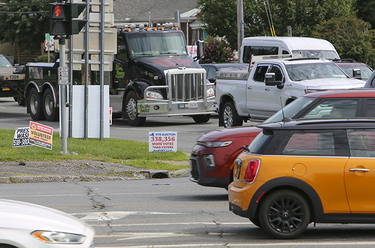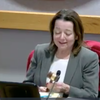Don’t fall for fuzzy election math
GUILDERLAND — At the busy corner of routes 155 and 20 in Guilderland, an innocuous-looking sign by the side of the road puts forward a bold claim: more votes were cast in New York state than there are registered voters.
Although there’s little else on the sign aside from the web address for the group that apparently posted the sign, New York Citizens Audit, the insidious implication that there’s reason to doubt the results of an election is clear.
The sign doesn’t actually specify which election had 338,356 more votes than voters statewide, and a look at the results of the two most obvious candidates — the 2022 gubernatorial election and the 2020 general election, both already cleared of any widespread fraud — doesn’t clear it up.
New Yorkers alarmed by the sign’s claim can take uneasy assurance that voter turnout in both those elections is much, much too low for the number of votes to exceed the number of registered voters.
In November of 2020, the New York State Board of Elections had 13,555,547 voters on file. Meanwhile, voters cast 8,616,161 ballots for presidential candidates ranging from Joe Biden and Donald Trump to Kanye West and Phil Collins. That means a registered-voter turnout rate of around 64 percent.
In November of 2022, the board of elections had a record of 13,129,900 voters, of whom only 5,962,278 cast a ballot for governor that year (including blanks). That’s a turnout of around 45 percent.
According to its website, New York Citizens Audit is a group of volunteers who claim to be concerned about the integrity of elections. Videos on the site show that it has made presentations at state, county, and town government meetings, pushing its false or unverified claims about discrepancies in voter data, which range from missing dates of birth to multiple registrations for a single voter to voters missing identification.
Some of these claims are outlandishly false — such as that there were 1,074,115 registered voters in Erie County, which only has a population of around 950,000. The source of this is unclear, since voter rolls show that, in November of 2020, there were only 660,431 registered voters in Erie County.
In an email sent to The Enterprise and signed by Art Zark, a fictional character designed by New York Citizens Audit who hosts so-called educational sessions, the group went to great lengths to square its figures against publicly available information, relying on increasingly complicated relationships between the data.
Where outright fraud can’t be suggested, the group falls back on the belief that the “butter-fingered incompetents doing the data entry” are creating “opportunities for election fraud,” and that the apparent refusal to fire these people has implications for the “competence or incompetence” of election officials.
Ultimately, the group appeals to emotion, as many conspiracy theorists do, asking people to ask themselves, “Are you comfortable with elections being run this way?”
Rebuttal
Despite the group’s ability to create clouds around the information, much of this confusion and misinformation can and has been dispelled by those who understand the data — though some claims are so detached from official data as to be unanswerable.
“It should be noted that no one has seen the actual data used to create the false claims,” state Board of Elections Co-Director Kristen Zebrowski Stavisky wrote in a letter addressed to various county-level government staff and officials that accompanied a document of the board’s rebuttals to the group. “Even members of the press have not been privy to the alleged voter list the group is using. Without seeing their ‘data,’ it is difficult to explain every supposed anomaly.”
Of the claim that some voters have more than one voter ID number, the board of elections states that this is normal and has no practical effect on the elections. If an already-registered voter registers again, the board says, the existing information is made redundant and the new information becomes active. The examples that New York Citizens Audit has given, the board said, mostly involved these “purged” records.
“There were many examples given where the same voter was listed in multiple counties,” the board of elections states in its rebuttal. “Again, the group failed to look at the voter’s status. There will always be some overlap as a voter moves from one jurisdiction and registers in another.”
It notes that a crime occurs when a voter actually votes or attempts to vote in two places.
New York Citizens Audit acknowledged this phenomenon in its email, tentatively admitting that it brings the numbers “into the realm of the possible,” going on to provide an overly-elaborate explanation of other means by which the discrepancy could be justified, but then circling back around to accept the number calculated by both The Enterprise and the board of elections.
“What this means in relation to duplicates is that I can't tell you without considerable effort how many of Nassau’s 62,371 duplicates relate to records in other counties that might also be active,” they wrote. “For this reason, it is not correct to say that any or all of those duplicates should be subtracted from the total. It may be (and likely is the case), that the other half of each duplicate is not in Nassau, and therefore subtracting those records would leave no representative records for those voters in Nassau. Because they are all active status, I don't think any should be subtracted without a good reason.
“In other words,” they said, “the 87.36% estimated registered voters is likely close to the true number.”
Of records showing voters without birthdays or having birthdays that are unusual, the board of elections notes that, prior to 1960, a date of birth was not required, and that, when electronic databases were implemented, some counties would use placeholder dates to fill the empty space for voters who hadn’t been required to provide their date of birth.
New York Citizens Audit also claims that the fact that voters have been registered on federal holidays is evidence of fraud or maladministration, to which the board of elections replied that, because some voters submit a registration form prior to their 18th birthday, the registration becomes active on that birthday, which may be a holiday. Also, Jan. 1 is sometimes used as a placeholder where necessary.
A letter from the Ontario County Board of Elections about the group’s claims sums things up more bluntly.
“The complexity of the voter enrollment database(s) combined with their very dynamic nature is poorly understood by nearly everyone except those who work closely with the information,” it says. “That lack of understanding makes it very easy to exploit preconceived notions about the entire elections process … All data provided by this group have been debunked by our peers.”



